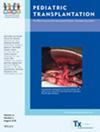胆道闭锁婴幼儿急性-慢性肝功能衰竭的术后结果
IF 1.4
4区 医学
Q3 PEDIATRICS
引用次数: 0
摘要
导言急性肝衰竭(ACLF)与胆道闭锁(BA)患者死亡率和发病率的增加有关。我们对 2011 年至 2021 年期间在本院接受 LT 的 18 岁胆道闭锁患者进行了回顾性分析。结果 在接受LT的107例患者中(65%为女性;中位年龄14 [9-31]个月),13例(12%)在LT前入院时出现ACLF。2例(15%)为1级,4例(30%)为2级,7例(55%)为≥3级前交叉韧带损伤。与无 ACLF 组相比,ACLF 组患者在入院时(5 [4-8] 个月 vs. 9 [6-24] 个月;p < .001)和 LT 时(8 [8-11] 个月 vs. 16 [10-40] 个月,p < .001)更年轻。术中,ACLF 患者失血量更高(40 [20-53] 对 10 [6-19] mL/kg;p < .001),输血需求更高(33 [21-69] 对 18 [7-25] mL/kg;p = .004)。术后,他们需要更多的血管加压支持(31% vs. 10.6%;p = .04),住院总时间也更长(106 [45-151] 天 vs. 13 [7-30] 天;p = .023)。结论尽管围手术期并发症较高,但ACLF患者在LT术后的生存状况良好,与无ACLF患者相当。这些令人鼓舞的数据重申了对这些重症患儿进行LT器官分配时的优先顺序。本文章由计算机程序翻译,如有差异,请以英文原文为准。

Postoperative outcomes of acute‐on‐chronic liver failure in infants and children with biliary atresia
IntroductionAcute‐on‐chronic liver failure (ACLF) is associated with increased mortality and morbidity in patients with biliary atresia (BA). Data on impact of ACLF on postoperative outcomes, however, are sparse.MethodWe performed a retrospective analysis of patients with BA aged <18 years who underwent LT between 2011 and 2021 at our institution. ACLF was defined using the pediatric ACLF criteria: ≥1 extra‐hepatic organ failure in children with decompensated cirrhosis.ResultsOf 107 patients (65% female; median age 14 [9–31] months) who received a LT, 13 (12%) had ACLF during the index admission prior to LT. Two (15%) had Grade 1; 4 (30%) had Grade 2; and 7 (55%) had Grade ≥3 ACLF. ACLF cohort was younger at time of listing (5 [4–8] vs. 9 [6–24] months; p < .001) and at LT (8 [8–11] vs. 16 [10–40] months, p < .001) compared to no‐ACLF group. Intraoperatively, ACLF patients had higher blood loss (40 [20–53] vs. 10 [6–19] mL/kg; p < .001) and blood transfusion requirements (33 [21–69] vs. 18 [7–25] mL/kg; p = .004). Postoperatively, they needed higher vasopressor support (31% vs. 10.6%; p = .04) and had higher total hospital length of stay (106 [45–151] vs. 13 [7–30] days; p = .023). Rate of return to the operating room, hospital readmission rates, and 1‐year post‐LT survival rates were comparable between the groups.ConclusionDespite higher perioperative complications, survival outcomes for ACLF in BA after LT are favorable and comparable to those without ACLF. These encouraging data reiterate prioritization during organ allocation of these critically ill children for LT.
求助全文
通过发布文献求助,成功后即可免费获取论文全文。
去求助
来源期刊

Pediatric Transplantation
医学-小儿科
CiteScore
2.90
自引率
15.40%
发文量
216
审稿时长
3-8 weeks
期刊介绍:
The aim of Pediatric Transplantation is to publish original articles of the highest quality on clinical experience and basic research in transplantation of tissues and solid organs in infants, children and adolescents. The journal seeks to disseminate the latest information widely to all individuals involved in kidney, liver, heart, lung, intestine and stem cell (bone-marrow) transplantation. In addition, the journal publishes focused reviews on topics relevant to pediatric transplantation as well as timely editorial comment on controversial issues.
 求助内容:
求助内容: 应助结果提醒方式:
应助结果提醒方式:


